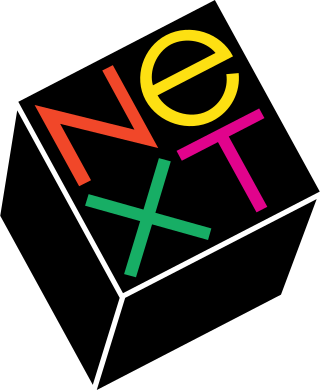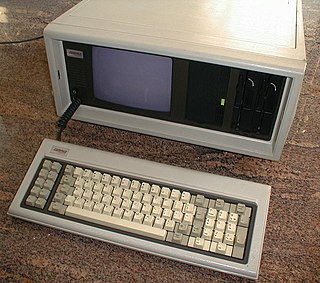Related Research Articles

NeXT, Inc. was an American technology company headquartered in Redwood City, California that specialized in computer workstations for higher education and business markets, and later developed web software. It was founded in 1985 by CEO Steve Jobs, the Apple Computer co-founder who had been forcibly removed from Apple that year. NeXT debuted with the NeXT Computer in 1988, and released the NeXTcube and smaller NeXTstation in 1990. The series had relatively limited sales, with only about 50,000 total units shipped. Nevertheless, the object-oriented programming and graphical user interface were highly influential trendsetters of computer innovation.

NeXTSTEP is a discontinued object-oriented, multitasking operating system based on the Mach kernel and the UNIX-derived BSD. It was developed by NeXT Computer, founded by Steve Jobs, in the late 1980s and early 1990s and was initially used for its range of proprietary workstation computers such as the NeXTcube. It was later ported to several other computer architectures.

"IBM PC–compatible" refers to a class of computers that are technically compatible with the 1981 IBM PC and subsequent XT and AT models from computer giant IBM. Like the original IBM PC, they use an Intel x86 central processing unit and are capable of using interchangeable commodity hardware, such as expansion cards. Initially such computers were referred to as PC clones, IBM clones or IBM PC clones, but the term "IBM PC compatible" is now a historical description only, as the vast majority of microcomputers produced since the 1990s are IBM compatible. IBM itself no longer sells personal computers, having sold its division to Lenovo in 2005. "Wintel" is a similar description that is more commonly used for modern computers.

OpenStep is an object-oriented application programming interface (API) specification developed by NeXT. It provides a framework for building graphical user interfaces (GUIs) and developing software applications. OpenStep was designed to be platform-independent, allowing developers to write code that could run on multiple operating systems, including NeXTSTEP, Windows NT, and various Unix-based systems. It has influenced the development of other GUI frameworks, such as Cocoa for macOS, and GNUstep.

Lisa is a desktop computer developed by Apple, produced from January 19, 1983 to August 1, 1986, and succeeded by Macintosh. It is generally considered the first mass-market personal computer operable through a graphical user interface (GUI). In 1983, a machine like the Lisa was still so expensive that it was primarily marketed to individual and small and medium-sized businesses as a groundbreaking new alternative to much bigger and more expensive mainframes or minicomputers such as from IBM, that either require additional, expensive consultancy from the supplier, hiring specially trained personnel, or at least, a much steeper learning curve to maintain and operate. Earlier GUI-controlled personal computers were not mass-marketed; for example, Xerox PARC manufactured its Alto workstation only for Xerox and select partners from the early to mid-1970s.

Taligent Inc. was an American software company. Based on the Pink object-oriented operating system conceived by Apple in 1988, Taligent Inc. was incorporated as an Apple/IBM partnership in 1992, and was dissolved into IBM in 1998.

A/UX is a Unix-based operating system from Apple Computer for Macintosh computers, integrated with System 7's graphical interface and application compatibility. It is Apple's first official Unix-based operating system, launched in 1988 and discontinued in 1995 with version 3.1.1. A/UX requires select 68k-based Macintosh models with an FPU and a paged memory management unit (PMMU), including the Macintosh II, SE/30, Quadra, and Centris series.

OPEN LOOK is a graphical user interface (GUI) specification for UNIX workstations. It was originally defined in the late 1980s by Sun Microsystems and AT&T Corporation.

Andrew Jay Hertzfeld is an American software engineer who was a member of Apple Computer's original Macintosh development team during the 1980s. After buying an Apple II in January 1978, he went to work for Apple Computer from August 1979 until March 1984, where he was a designer for the Macintosh system software.

Susan Kare is an American artist and graphic designer, who contributed interface elements and typefaces for the first Apple Macintosh personal computer from 1983 to 1986. She was employee #10 and creative director at NeXT, the company formed by Steve Jobs after he left Apple in 1985. She has worked as a design consultant to Microsoft, IBM, Sony Pictures, Facebook, and Pinterest. As of 2023 Kare has been an employee of Niantic Labs. As a pioneer of pixel art and of the graphical computer interface, she has been celebrated as one of the most significant designers of modern technology.

The Macintosh, later rebranded as the Macintosh 128K, is the original Macintosh personal computer from Apple. It is the first successful mass-market all-in-one desktop personal computer with a graphical user interface, built-in screen and mouse. It was pivotal in establishing desktop publishing as a general office function. The motherboard, a 9 in (23 cm) CRT monochrome monitor, and a floppy drive are in a beige case with integrated carrying handle; it has a keyboard and single-button mouse.

WriteNow is a word processor application for the original Apple Macintosh and later computers in the NeXT product line. The application is one of two word processors that were first developed with the goal that they be available at the time of the Mac product launch in 1984, and was the primary word processor for computers manufactured by NeXT. WriteNow was purchased from T/Maker by WordStar in 1993, but shortly after that, WordStar merged with SoftKey, which ultimately led to its discontinuation. It had a combination of powerful features, excellent performance, and small system requirements.

Rhapsody is an operating system that was developed by Apple Computer after its purchase of NeXT in the late 1990s. It is the fifth major release of the Mach-based operating system that was developed at NeXT in the late 1980s, previously called OPENSTEP and NEXTSTEP. Rhapsody was targeted to developers for a transition period between the Classic Mac OS and Mac OS X. Rhapsody represented a new and exploratory strategy for Apple, more than an operating system, and runs on x86-based PCs and on Power Macintosh.

Interface Builder is a software development application for Apple's macOS operating system. It is part of Xcode, the Apple Developer developer's toolset. Interface Builder allows Cocoa and Carbon developers to create interfaces for applications using a graphical user interface. The resulting interface is stored as a .nib file, short for NeXT Interface Builder, or more recently, as an XML-based .xib file.
Steve Capps is a pioneering American computer programmer and software engineer, who was one of the original designers of the Apple Macintosh computer and co-designers of the Finder in the 1980s. He also led development of the Apple Newton PDA and designed music software such as SoundEdit, before developing user interface (UI) designs for Microsoft's Internet Explorer and online/mobile payment systems.

Apple Inc., originally Apple Computer, Inc., is a multinational corporation that creates and markets consumer electronics and attendant computer software, and is a digital distributor of media content. Apple's core product lines are the iPhone smartphone, iPad tablet computer, and the Mac personal computer. The company offers its products online and has a chain of retail stores known as Apple Stores. Founders Steve Jobs, Steve Wozniak, and Ronald Wayne created Apple Computer Co. on April 1, 1976, to market Wozniak's Apple I desktop computer, and Jobs and Wozniak incorporated the company on January 3, 1977, in Cupertino, California.

The architecture of macOS describes the layers of the operating system that is the culmination of Apple Inc.'s decade-long research and development process to replace the classic Mac OS.
Richard Page is an alumnus of Apple Inc. He was an Apple Fellow at Apple Computer in the 1980s, and later joined Steve Jobs at NeXT.

The Boston Computer Society (BCS) was an organization of personal computer users, based in Boston, Massachusetts, U.S., that ran from 1977 to 1996. At one point, it was the largest such group in the world, with regular user group meetings, many publications, permanent offices in Boston, and hosting major product announcements, including the East Coast release of the Apple Macintosh in 1984.
Mac operating systems were developed by Apple Inc. in a succession of two major series.
References
- ↑ Raskin, Jef (May 1984). "More Mac Reactions". BYTE (letter). Vol. 9, no. 5. p. 20. Retrieved 23 October 2013.
- ↑ Hertzfeld, Andy (2004). Revolution in the Valley. O'Reilly Books. p. 24. ISBN 0-596-00719-1.
- ↑ Deutschman, Alan (2001). The Second Coming of Steve Jobs . Broadway. p. 34. ISBN 0-7679-0433-8.
- ↑ Dalrymple, Jim (January 9, 2002). "Bud Tribble Returns to Apple". Macworld. Archived from the original on February 14, 2012. Retrieved March 23, 2011.
- ↑ Markoff, John (February 21, 2000). "Technology; Building an Alternative to Windows" . The New York Times. Retrieved March 23, 2011.
- ↑ Sumra, Hussein (21 March 2016). "Siri and iAd Restricted by Apple 'Policy Czars' to Limit Customer Data Collection". MacRumors.